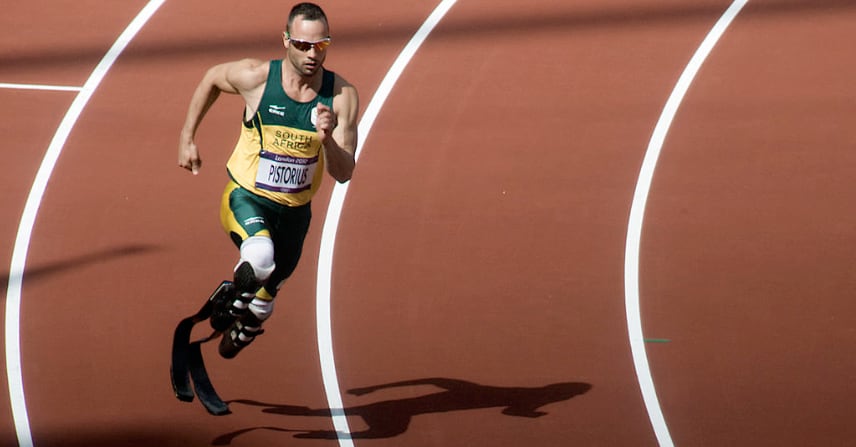Privilege, Power, and The Self-Made Man
Sports have always provided a window into society at-large, and especially society under capitalism. Competition under capitalism is enshrined as a consequence of the inalienable rights to life, liberty, and property. Success or failure are attributed to the relative competitiveness of a person, group of people, and the commodities they bring to the market. Sport and its officiation provide a glimpse into how we think about competition, and especially what we think is fair.

Caster Semenya is a world champion runner and Olympic gold medalist from South Africa. She was banned from competition following questions about her gender. Swiss courts ruled that she would not be allowed to compete unless she agreed to be treated with hormone-suppressing drugs.
This fascinating display of stupidity was part of an ongoing panic over the idea that transgender women were poised to ruin women’s sports. Some believe that there are even student athletes who would transition for the sole purpose of making themselves more competitive.
In order to preserve the fairness of women’s competition, the IAAF was willing to draft an arbitrary chemical definition of what it means to be a woman and to enforce that standard by mandating hormone therapy for a female athlete.

Around the same time, another South African athlete was also raising questions about fairness in competition. Oscar Pistorius, nicknamed The Blade Runner, is a double amputee and paralympic champion. He competed in the 2012 Summer Olympic Games, where people began to question whether his racing prosthetics provided him with an unfair advantage over his non-disabled peers.
In a way similar to how women’s sports had long been segregated from the competition of men, disabled athletes had long been separated from their non-disabled peers and made to compete in special events. This wasn’t done to preserve the fairness of general competition, but to provide a fair contest for disabled athletes who were considered disadvantaged compared to those who had full use of their bodies.
When Pistorius began winning against non-disabled runners in international competition, the IAAF amended its rules banning the use of technical devices and began monitoring the track performance of runners using prosthetics to make sure those devices weren’t conferring an unfair advantage.
Socially Constructed Difference
Historically, people have been segregated during competition on the basis of socially constructed differences; race, gender, disability. The baseball color line, for example, was a mirror of the segregation between black and white people in the whole of American society; an extension of the already un-level playing field.
The case in favor of segregating sports for women and the disabled is based on the presumed superiority of men and the able-bodied, but ostensibly for the purpose of creating a level playing field for oppressed groups. It would not be fair for women to have to compete against men - with the advantages of height and testosterone - or for a man who lost his lower limbs to compete against men whose bodies are still whole.
If there was, however, a female athlete to which nature conferred the “male” advantages of high testosterone, she would have to be chemically corrected. If an amputee could qualify for international competition accommodated by prosthetics, that technology would have to meet specifications such that the athlete had no advantage.
Otherwise it wouldn’t be fair.
Biotechnically Constructed Difference
Semenya and Pistorius have been caught in the reaction to an emerging biotechnically constructed difference.
Semenya is not even doing hormone replacement therapy, and yet the reaction to athletes who are has been so strong, and the scramble to create a definition of womanhood that excludes them so rushed, that her choices were to either accept a chemically induced handicap or be banned from competition altogether. Pistorius (at least before being convicted for murder) was inspirational to behold on the olympic track with his composite carbon fiber blades, but already his presence raised an important question; what if one day a runner with prosthetics wasn’t just competitive, but dominant?
That dominance would not come from a natural difference, but from superior technology. In Semenya’s case, regulators hoped that through biotechnology her dominance could be corrected.
The differences between these runners and the people they are competing against are biotechnically constructed. It would be unfair for Pistorius to dominate races due to superior materials and engineering. In order to be fair to other runners, Semenya was asked to accept what amounts to a biochemical disability so she would fit within their endocrinological definition of “competitive”.
Privilege, Power, and Biotechnical Difference
In Privilege, Power, and Difference, Allan G. Johnson plainly describes how socially constructed differences have manifested systems of privilege and oppression. He also clearly explains the role of one economic system, capitalism, in exploiting the inequality of those systems to conserve power and produce profit for the benefit of a small few.
What will happen as biotechnically constructed difference becomes more prevalent?
Historically, socially constructed differences have been used to devalue people’s labor. People with disabilities in the United States are still payed sub-minimum wage for their work in sheltered workshops. The gender pay gap is narrowing but remains.
Biotechnically constructed difference will be no less useful as a basis to devalue labor, and this may even be the force that inevitably drives its adoption. Non-augmented individuals will be less productive than their augmented peers. The pressure to remain competitive may create what Johnson calls a “path of least resistance” for human augmentation.
Workplaces, centered around privilege and productivity, would identify augmented individuals as dominant. That dominance stacks the deck in favor of people accepting human augmentation as the cost of doing business. What’s jarring about this discussion is that we’re not talking about paths of least resistance that lead towards racist and sexist behavior but to invasive, permanent surgeries.
Patrick Lin and his co-authors predicted as much in regards to military servicemen in a 2013 paper, Enhanced Warfighters: Risk, Ethics, and Policy (2013)
Some warfighters will be privileged (or unlucky?) enough to be appropriately enhanced for their mission, whereas some others may be underenhanced, while others yet will remain “normal.” In broader society, we see that uneven access to technology creates a gap between the haves and the have-nots, such as the Internet divide (Rozner 1998); and this translates into a difference in quality of life, education, earnings, and so on. It is therefore not unreasonable to expect a similar effect within the military.
as well as the strings of exploitation attached to those enhanced capabilities,
Insofar as an enhancement is costly to develop and represents an investment, it may be reasonable to expect the enhanced warfighter to commit to longer service. But if an enhancement is seen more as a mere risk, then perhaps a shorter length of service is appropriate for the enhanced. Similar decisions may need to be made with respect to pay, promotions, and so on. For instance, if promotions and “danger pay” may be used to incentivize volunteers, enhanced soldiers could be better positioned and more likely to accept dangerous missions in exchange for those benefits.
And echoed in Human By Design: An Ethical Framework For Human Augmentation
Limitations can be justifiable inasmuch as technology can increase disparity and inequality, reduce autonomy, and increase suffering of some while disproportionately benefiting others.
There is significant potential for social disruption as a result of human augmentation. Current disparities in access to medical treatments or assistive technologies are inherently disruptive. Societal discord may arise due to limited access to augmentation for specific groups, explicit augmentation requirements for employment, or superior capacity or performance by augmented individuals creating de facto obligations for individuals.
The Myth of the Self-Made Man
The concerns already nagging at the consciences of those speculating about the effects of these emerging biotechnical differences can be stated in extremely simple terms: our society isn’t fair. Human augmentation will only make it less so.
For many transhumanists, the use of technology to improve our bodies and cognition are a path towards becoming the great American myth of the self-made man. Our success will lie within ourselves; with our technical ability, our ability to exert control over our bodies. To re-make ourselves.
The myth of the self-made man only endures because we ignore the roles of power and privilege. Those that hold power need us to believe that they merit that power. It is a sin to suggest that someone’s success is the result of the privilege afforded to them by their race, their gender, or their inherited wealth.
Ultimately what powerful people fear most - the thing that every system of privilege and oppression prevents - is competition on a level playing field; a fair fight.
While we wrestle with how to fit individuals with emergent biotechnical differences into our existing systems of privilege and socialization, we must also consider that biotechnical differences in the future are likely to only reinforce our present systems of oppression; that existing forms of privilege are a gateway to the medicine and technology that we have now.
As a final piece of evidence, consider that the prosthetics worn by Pistorius cost at least $15,000 each and whether or not you could hope to afford even one.